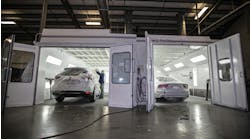Labor is the biggest issue we face today and having processes in place to optimize this limited resource is critical.
Labor is the largest single profit center in the shop, and labor produced directly leads to more parts and material sales. For some reason, however, shops tend to focus the energy elsewhere; many spend more time focused on material management than labor optimization even though labor contributes five times more profit.
Why do shops do this? From our vantage point, shops continue to waste labor because they don’t see it as something they have direct control over. But they do – control is in the processes we’ve developed.
Shops cannot operate as if labor is in unlimited supply. The answer isn’t to add more people when more people aren’t available. When you can’t recruit, you optimize the labor you have in-house, right now.
Consider industry KPIs showing touch times between 2 to 4 hours per day and compare that to the actual hours worked and you quickly realize that as an industry, shops are wasting 50 percent to 60 percent of available labor each day.
We defend this by saying things like, “My techs are 200 percent efficient,” while not considering that efficiency came from building a flag sheet over multiple open repair orders, not the actual goal of getting paid to deliver completed cars.
Wasted labor creates a stream of unhappiness — unhappy customers, unhappy work providers and unhappy employees. Employees are the answer to the labor shortage, which is why working smarter, not harder is key. Processes impact the shop and its employees positively – in income, quality of life and recruitment efforts.
However, as we all know, change is never easy, and it comes with a cost; but the cost is clearly outweighed by the gain. To illustrate what I mean around touch time, divide your shop’s monthly sales by the number of total labor hours sold.
Example: $200,000 in sales/1000 hours = $200 an hour
This is your shop’s average sale per hour. Now, consider if that 200 percent efficient tech was able to have just one more hour of touch time a day. At 200 percent efficiency, that would add two more labor hours to his or her workday.
Take those two additional labor hours and multiply that by the number of techs and then multiply that number by the number of monthly working days. Finally, multiply that number by sales per hour in the previous formula.
Example: 2 new hours X 6 technicians X 21 working days X $200 an hour in sales = $50,400
That’s a 25 percent increase in sales utilizing your existing technicians, but optimized to improve touch time.
The answer to improving touch time revolves around one key principle: keep our skilled technicians on task in the repair bay.
Among the best practices to do this include:
Scheduling to production capacity rather than grabbing the keys
Completing the damage assessment before production rather than tear down in production
Verifying critical parts are on hand before the vehicle enters production rather than starting on it and having to stop
Verifying parts for accuracy and quality before production
Verifying and validating quality electronically during the repair phases to eliminate redoes rather than a post repair inspection
Reducing wasted movement by having materials readily available at the vehicle rather than centralized supply cabinets
Communicating electronically to focus on task(s) rather than chasing people and parts around the shop
Labor optimization is critical to the survival of the industry and ultimately, to the survival of your shop.
Education is the first step in improvement. As a part of our A-Plus™ University program, we provide shops with ongoing critical training covering the topics needed to optimize labor. Our curriculum is supported by well-known industry experts, including Mike Anderson from Collision Advice.
Live and recorded “virtual” courses are offered monthly at no charge to you or your team.
For a complete listing of educational programming available by Sherwin-Williams, visit sherwin-automotive.com/aplusuniversity.





